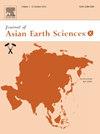Morphogenesis of the Holocene coastal landforms on Sumba Island, Indonesia
IF 2.3
Q3 GEOSCIENCES, MULTIDISCIPLINARY
引用次数: 0
Abstract
Coastal terraces, whether erosional, depositional, or bio-constructed, have been widely used to quantify Late Cenozoic vertical deformation and relative sea-level changes. Here, we review and investigate the Holocene coastal terraces of Sumba Island, Indonesia. We describe fifteen coastal sites, evenly distributed between the South and North coasts. The terraces are Holocene age, based on 14C and U/Th ages. We show that the preservation of coastal terraces in Sumba is favoured on the leeward coast (North). Holocene and older Pleistocene coastal terraces are almost absent on the windward coast (South), although modern coral reefs almost ubiquitously thrive. The morphology and the nature of the bedrock varies between the two sides of the island: while sequences of earlier Pleistocene coral reef limestones dominate in the North, Miocene/Pliocene tuffs and pelagic carbonates outcrop on the southern coast. The elevations of the Holocene inner edges range from 2.4 ± 0.7 to 6.9 ± 0.7 m above the present mean sea level. Despite disparate uplift rates, the three preserved windward terraces (out of the seven sites investigated) generally have a higher inner edge than leeward terraces. We conclude that neither glacio-eustatic oscillations, vertical deformation rates nor hydrodynamics by themselves can explain the variability in inner edge elevations on Sumba, but only a complex combination of these processes. Finally, our study serves as a solid basis for future investigation of the Holocene landforms of the island of Sumba and other similar tropical coastal zones.
印度尼西亚松巴岛全新世海岸地貌的形态发生
海岸阶地,无论是侵蚀的、沉积的还是生物构造的,都被广泛用于量化晚新生代垂直变形和相对海平面变化。本文对印度尼西亚松巴岛全新世海岸阶地进行了回顾和研究。我们描述了15个沿海地点,均匀分布在南北海岸之间。根据14C和U/Th年龄,阶地为全新世。我们表明,保存沿海梯田在松巴是有利的背风海岸(北)。在向风海岸(南),虽然现代珊瑚礁几乎无处不在,但全新世和更古老的更新世海岸梯田几乎没有。岛的两侧基岩的形态和性质各不相同:北部主要是更新世早期的珊瑚礁灰岩,南部海岸则是中新世/上新世的凝灰岩和远洋碳酸盐岩。全新世内缘海拔高度在2.4±0.7 ~ 6.9±0.7 m之间。尽管隆升率不同,但在调查的七个地点中,三个保存完好的迎风梯田通常比背风梯田具有更高的内边缘。我们得出结论,无论是冰川-上升振荡、垂直变形速率还是流体动力学本身都不能解释松巴内缘海拔的变化,而只能是这些过程的复杂组合。最后,本研究为今后对松巴岛及其他类似热带沿海地区全新世地貌的研究提供了坚实的基础。
本文章由计算机程序翻译,如有差异,请以英文原文为准。
求助全文
约1分钟内获得全文
求助全文
来源期刊

Journal of Asian Earth Sciences: X
Earth and Planetary Sciences-Earth-Surface Processes
CiteScore
3.40
自引率
0.00%
发文量
53
审稿时长
28 weeks
 求助内容:
求助内容: 应助结果提醒方式:
应助结果提醒方式:


